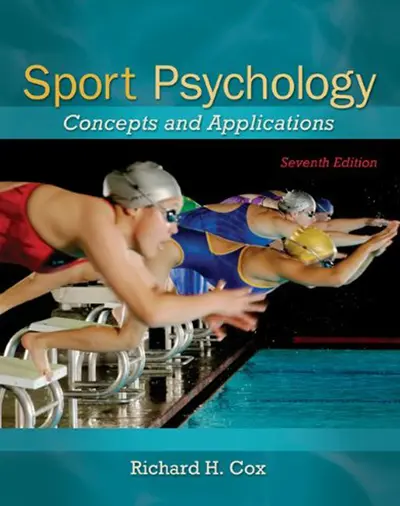My Account Details

ISBN10: 0078022479 | ISBN13: 9780078022470

* The estimated amount of time this product will be on the market is based on a number of factors, including faculty input to instructional design and the prior revision cycle and updates to academic research-which typically results in a revision cycle ranging from every two to four years for this product. Pricing subject to change at any time.
Instructor Information
Quick Actions (Only for Validated Instructor Accounts):
Sport Psychology: Concepts and Applications shows how concepts supported by current scientific research can be used to address issues and situations encountered everyday by physical activity specialists, coaches, athletic trainers, and athletes.
This introduction to sport and exercise psychology addresses practical issues, such as dealing with anxiety, arousal, and stress; developing coping, relaxation, motivation, and energizing strategies; understanding the effects of an audience on human performance; building team cohesion; and preventing burnout and other negative effects.
PART I. Understanding Sport Psychology
1 Foundations of Sport Psychology2 Personality as a Core Characteristic of the Athlete PART II. Motivation in Sport and Exercise
3 Self-Confidence and Intrinsic Motivation4 Goal Perspective Theory5 Youth SportsPART III. Effects of Attention, Emotion, and Mood on Performance
6 Attention and Concentration in Sport and Exercise7 Anxiety, Stress, and Mood Relationships8 Alternatives to Inverted-U TheoryPART IV.Cognitive and Behavioral Interventions
9 Coping and Intervention Strategies in Sport10 Goal Setting in Sport11 Imagery and Hypnosis in Sport 12 Psychological Skills TrainingPART V. Social Psychology of Sport
13 Aggression and Violence in Sport 14 Audience and Self-Presentation Effects in Sport15 Team Cohesion in Sport16 Leadership and Communication in Sport PART VI. Psychobiology of Sport and Exercise
17 Exercise Psychology18 The Psychology of Athletic Injuries and Career Termination19 Drug Abuse in Sport and Exercise
PART II. Motivation in Sport and Exercise
3 Self-Confidence and Intrinsic Motivation4 Goal Perspective Theory5 Youth SportsPART III. Effects of Attention, Emotion, and Mood on Performance
6 Attention and Concentration in Sport and Exercise7 Anxiety, Stress, and Mood Relationships8 Alternatives to Inverted-U TheoryPART IV.Cognitive and Behavioral Interventions
9 Coping and Intervention Strategies in Sport10 Goal Setting in Sport11 Imagery and Hypnosis in Sport 12 Psychological Skills TrainingPART V. Social Psychology of Sport
13 Aggression and Violence in Sport 14 Audience and Self-Presentation Effects in Sport15 Team Cohesion in Sport16 Leadership and Communication in Sport PART VI. Psychobiology of Sport and Exercise
17 Exercise Psychology18 The Psychology of Athletic Injuries and Career Termination19 Drug Abuse in Sport and Exercise
5 Youth SportsPART III. Effects of Attention, Emotion, and Mood on Performance
6 Attention and Concentration in Sport and Exercise7 Anxiety, Stress, and Mood Relationships8 Alternatives to Inverted-U TheoryPART IV.Cognitive and Behavioral Interventions
9 Coping and Intervention Strategies in Sport10 Goal Setting in Sport11 Imagery and Hypnosis in Sport 12 Psychological Skills TrainingPART V. Social Psychology of Sport
13 Aggression and Violence in Sport 14 Audience and Self-Presentation Effects in Sport15 Team Cohesion in Sport16 Leadership and Communication in Sport PART VI. Psychobiology of Sport and Exercise
17 Exercise Psychology18 The Psychology of Athletic Injuries and Career Termination19 Drug Abuse in Sport and Exercise
7 Anxiety, Stress, and Mood Relationships8 Alternatives to Inverted-U TheoryPART IV.Cognitive and Behavioral Interventions
9 Coping and Intervention Strategies in Sport10 Goal Setting in Sport11 Imagery and Hypnosis in Sport 12 Psychological Skills TrainingPART V. Social Psychology of Sport
13 Aggression and Violence in Sport 14 Audience and Self-Presentation Effects in Sport15 Team Cohesion in Sport16 Leadership and Communication in Sport PART VI. Psychobiology of Sport and Exercise
17 Exercise Psychology18 The Psychology of Athletic Injuries and Career Termination19 Drug Abuse in Sport and Exercise
PART IV.Cognitive and Behavioral Interventions
9 Coping and Intervention Strategies in Sport10 Goal Setting in Sport11 Imagery and Hypnosis in Sport 12 Psychological Skills TrainingPART V. Social Psychology of Sport
13 Aggression and Violence in Sport 14 Audience and Self-Presentation Effects in Sport15 Team Cohesion in Sport16 Leadership and Communication in Sport PART VI. Psychobiology of Sport and Exercise
17 Exercise Psychology18 The Psychology of Athletic Injuries and Career Termination19 Drug Abuse in Sport and Exercise
11 Imagery and Hypnosis in Sport 12 Psychological Skills TrainingPART V. Social Psychology of Sport
13 Aggression and Violence in Sport 14 Audience and Self-Presentation Effects in Sport15 Team Cohesion in Sport16 Leadership and Communication in Sport PART VI. Psychobiology of Sport and Exercise
17 Exercise Psychology18 The Psychology of Athletic Injuries and Career Termination19 Drug Abuse in Sport and Exercise
PART V. Social Psychology of Sport
13 Aggression and Violence in Sport 14 Audience and Self-Presentation Effects in Sport15 Team Cohesion in Sport16 Leadership and Communication in Sport PART VI. Psychobiology of Sport and Exercise
17 Exercise Psychology18 The Psychology of Athletic Injuries and Career Termination19 Drug Abuse in Sport and Exercise
15 Team Cohesion in Sport16 Leadership and Communication in Sport PART VI. Psychobiology of Sport and Exercise
17 Exercise Psychology18 The Psychology of Athletic Injuries and Career Termination19 Drug Abuse in Sport and Exercise
PART VI. Psychobiology of Sport and Exercise
17 Exercise Psychology18 The Psychology of Athletic Injuries and Career Termination19 Drug Abuse in Sport and Exercise
19 Drug Abuse in Sport and Exercise
Need support? We're here to help - Get real-world support and resources every step of the way.